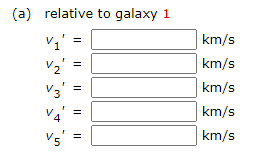The great astronomer Edwin Hubble discovered that all distant galaxies are receding from our Milky Way Galaxy with velocities proportional to their distances. It appears to an observer on the Earth that we are at the center of an expanding universe. The figure below illustrates this for five galaxies lying along a straight line, with the Milky Way Galaxy at the center. Galaxy 1 300 Mly Galaxy 2 150 Mly Galaxy 3 MW Galaxy 4 190 Mly Galaxy 5 450 Mly v, = -4500 km/s v, = -2200 km/s V, = 2830 km/s V = 6700 km/s Using the data from the figure, calculate the velocities (in km/s) relative to the galaxies below. The results mean that observers on all galaxies will see themselves at the center of the expanding universe, and they would likely be aware of relative velocities, concluding that it is not possible to locate the center of expansion with the given information.
The great astronomer Edwin Hubble discovered that all distant galaxies are receding from our Milky Way Galaxy with velocities proportional to their distances. It appears to an observer on the Earth that we are at the center of an expanding universe. The figure below illustrates this for five galaxies lying along a straight line, with the Milky Way Galaxy at the center. Galaxy 1 300 Mly Galaxy 2 150 Mly Galaxy 3 MW Galaxy 4 190 Mly Galaxy 5 450 Mly v, = -4500 km/s v, = -2200 km/s V, = 2830 km/s V = 6700 km/s Using the data from the figure, calculate the velocities (in km/s) relative to the galaxies below. The results mean that observers on all galaxies will see themselves at the center of the expanding universe, and they would likely be aware of relative velocities, concluding that it is not possible to locate the center of expansion with the given information.
University Physics Volume 3
17th Edition
ISBN:9781938168185
Author:William Moebs, Jeff Sanny
Publisher:William Moebs, Jeff Sanny
Chapter11: Particle Physics And Cosmology
Section: Chapter Questions
Problem 69P: Show that the velocity of a star orbiting its galaxy in a circular oibit is inversely proportional...
Related questions
Question
6a-please see attached

Transcribed Image Text:The great astronomer Edwin Hubble discovered that all distant galaxies are receding from our Milky Way Galaxy with velocities proportional to their distances. It appears to an observer
on the Earth that we are at the center of an expanding universe. The figure below illustrates this for five galaxies lying along a straight line, with the Milky Way Galaxy at the center.
Galaxy 1
300 Mly
Galaxy 2
150 Mly
Galaxy 3
MW
Galaxy 4
190 Mly
Galaxy 5
450 Mly
v, = -4500 km/s v, = -2200 km/s
V, = 2830 km/s
V = 6700 km/s
Using the data from the figure, calculate the velocities (in km/s) relative to the galaxies below. The results mean that observers on all galaxies will see themselves at the center of the
expanding universe, and they would likely be aware of relative velocities, concluding that it is not possible to locate the center of expansion with the given information.

Expert Solution
This question has been solved!
Explore an expertly crafted, step-by-step solution for a thorough understanding of key concepts.
This is a popular solution!
Trending now
This is a popular solution!
Step by step
Solved in 3 steps with 4 images

Knowledge Booster
Learn more about
Need a deep-dive on the concept behind this application? Look no further. Learn more about this topic, physics and related others by exploring similar questions and additional content below.Recommended textbooks for you

University Physics Volume 3
Physics
ISBN:
9781938168185
Author:
William Moebs, Jeff Sanny
Publisher:
OpenStax

College Physics
Physics
ISBN:
9781305952300
Author:
Raymond A. Serway, Chris Vuille
Publisher:
Cengage Learning

College Physics
Physics
ISBN:
9781938168000
Author:
Paul Peter Urone, Roger Hinrichs
Publisher:
OpenStax College

University Physics Volume 3
Physics
ISBN:
9781938168185
Author:
William Moebs, Jeff Sanny
Publisher:
OpenStax

College Physics
Physics
ISBN:
9781305952300
Author:
Raymond A. Serway, Chris Vuille
Publisher:
Cengage Learning

College Physics
Physics
ISBN:
9781938168000
Author:
Paul Peter Urone, Roger Hinrichs
Publisher:
OpenStax College

Physics for Scientists and Engineers, Technology …
Physics
ISBN:
9781305116399
Author:
Raymond A. Serway, John W. Jewett
Publisher:
Cengage Learning

Principles of Physics: A Calculus-Based Text
Physics
ISBN:
9781133104261
Author:
Raymond A. Serway, John W. Jewett
Publisher:
Cengage Learning